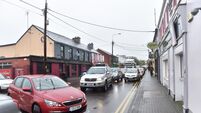Free space opens up a whole new world for artists
THE annual CIT Crawford College of Art and Design Fine Art & Ceramic Design Exhibition opens on Friday. This free exhibition provides 47 students with an opportunity to showcase their artistic endeavours.
As always, the exhibition runs in the Crawford college itself, but much of the art on display will have been made in the old Fás building on Sullivan’s Quay. This large building, which was also home to the tax office, is now owned by BAM Contractors and has become an interesting and unusual arts hub in the centre of the city. Its metamorphosis was inspired by this current group of fourth year art students, who used the space for their third year exhibition in 2010.
Orla Flynn is the acting head of the Crawford college&. “As part of their third year course, the students have a professional practice module where they learn about collaborative exhibition. As part of this process, they identified sites around the city that could hypothetically be used for displaying art,” says Flynn. “Interestingly, a number of real exhibitions arose from this exercise, including an exhibition at the old Cork prison. The third year students then went on to organise their own exhibition in the old Fás building.”
Impressed by the exhibition, the college has now rented the ground floor and first floor of this building to create formal studio spaces for this same group of students. The college will also use the building to house its art therapy department.
“Creativity is at the heart of art therapy and some interesting synergies may arise,” says Flynn. “Art therapy, like music and drama therapy, is considered mainstream in many countries and is starting to get a foothold here. We are starting to see this type of treatment become more mainstream as practitioners become members of clinical teams. It also has a strong role to play in an educational context.”
Outside of the college, other artists have also taken advantage of the light and space provided by the former Fás building.
Sample-Studios, a non-profit group, has created low-cost studios on the third floor. In the present market it seems to provide a win-win situation; the building is looked after and provides some rental income for the owners, and the artists and musicians get a fantastic working space in the city centre.
Solstice, which is part of the Midsummer Festival, will also run in the old Fás building this week. It will feature 150 artists with 33 shows over four days.
Despite reduced funding for arts, the current economic situation does have some advantages for artists, and the use of empty premises as exhibition spaces is now a relatively common practice in Ireland. “We are certainly starting to see some interesting collaborative efforts, such as the non-profit gallery Occupy in Limerick,” says Flynn. “Three of the artists from the similar Cork Contemporary Project in Cork are now exhibiting in the Don Gallery in Shanghai, which is twinned with Cork. It shows that these collaborative artist led projects can be important stepping stones.”
Raphael Llewellyn is one of the fourth year students on the organising committee of the graduate art exhibition. “My body of work is based on army training grounds and a meditation on their transient nature. Without working directly from the landscape I reconstruct their history and nature to suit my own vision. I would love to continue working in the arts when I finish. Having a working space in the city centre has been great; I think it is important to have a community of artists who can communicate and learn from each other.”
Although there may be new working and exhibiting spaces available, earning a reasonable living will be a huge challenge for this new crop of graduates. “The recent Arts Council report provides a shocking portrait of the artist’s lot in Ireland,” says Flynn. “Most artists make very little money from their artistic practice, however, the spin-off to the economy, although very difficult to quantify, is enormous.
“Art is not just about tourism and entertainment. We talk about numerical literacy but visual literacy can be equally important. It is a fundamental element in how we view our environment: it is a basic requirement, for example, in reading and understanding a planning file. Art graduates are good problem solvers, they are imaginative and are used to experimenting and these are valuable skills in the modern world.”
















